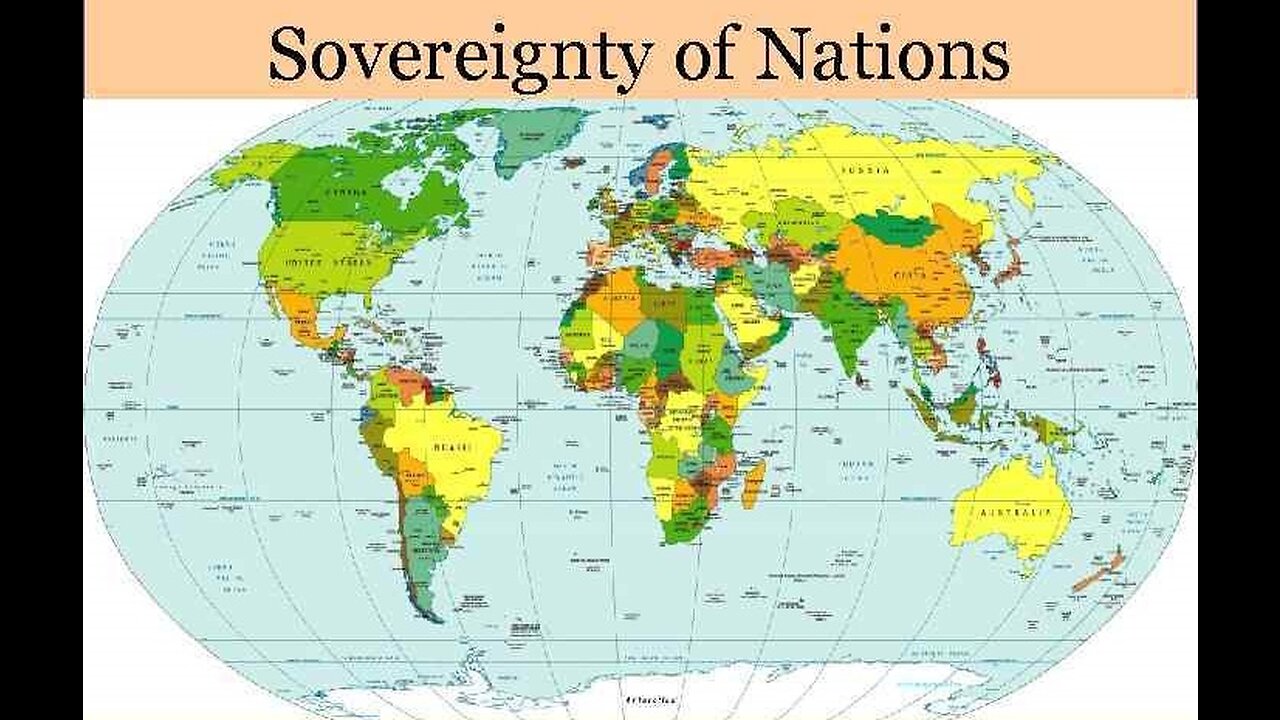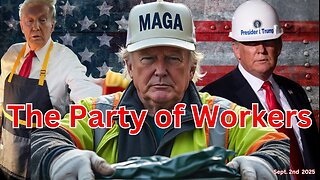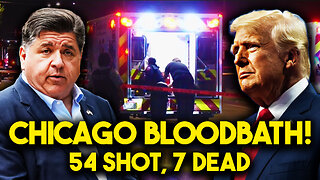Premium Only Content

10 Times America Helped Overthrow a Foreign Government and Our Sovereign Nations ?
The USA has long facilitated regime change to support its own strategic and business interests. A sovereign nation is a nation that has one centralized government that has the power to govern a specific geographic area. Also A Sovereignty Nation or Government is the power of a state to do everything necessary to govern itself, such as making, executing, and applying laws; imposing and collecting taxes; making war and peace; and forming treaties or engaging in commerce with foreign nations. Throughout its history, the United States has used its military and covert operations to overthrow or prop up foreign governments in the name of preserving U.S. strategic and business interests. United States signed some 368 treaties with various Indigenous people across the North American continent. The treaties were based on the fundamental idea that each tribe was an independent nation, with their own right to self-determination and self-rule. But as white settlers began moving onto Native American lands, this idea came into conflict with the relentless pace of westward expansion—resulting in many broken promises on the part of the U.S. government. So On the 17th of April, 1961, a bridge of Cuban exiles landed on the coast of the Bay of Pigs. Their aim was to instigate a popular uprising and to overthrow the revolutionary government of Fidel Castro. The attempt was a dismal failure. This film traces the course of events from March, 1960, when recruiting for a Cuban exile force started, up to and including the invasion itself. In the process it examines such aspects as the role of the C.I.A., the attitude of President Kennedy and the reasons for failure. (U.S.A. - N.B.C. Television, made by N.B.C. News, edited and distributed by Encyclopedia Britannica Films, B&W live action 1964)
U.S. intervention in foreign governments began with attacks on and displacement of sovereign tribal nations in North America. In the 1890s, this type of imperialist activity, fueled by the idea of Manifest Destiny, expanded overseas when the U.S. overthrew the Hawaiian Kingdom and annexed its islands. As America annexed more overseas territories for its empire, it began to intervene frequently in other countries’ governments—particularly those in its backyard.
“During the early 20th century, the United States intervened relentlessly in the Caribbean Basin,” says Stephen Kinzer, a senior fellow at the Watson Institute for International and Public Affairs at Brown University and author of Overthrow: America’s Century of Regime Change from Hawaii to Iraq.
After World War II, the United States began using the newly established Central Intelligence Agency to overthrow governments all over the world in a more covert manner. U.S. leaders rationalized many of these interventions as necessary for preventing the spread of communism according to the Cold War domino theory. Similarly, 21st-century leaders would later defend U.S. Middle East interventions as necessary for fighting terrorism.
1893: Hawaii In January 1893, a small group of white business and plantation owners, with the support of a U.S. envoy to Hawaii (Native spelling: Hawai'i), led a coup d'état that ousted the Hawaiian monarch Queen Liliʻuokalani from power. This came six years after the Queen's predecessor, her brother King David Kalakaua, was forced to sign a new constitution at gunpoint that stripped him of most of his powers and shifted them to members of the white planter class.
The coup leaders immediately pushed for the U.S. to annex Hawaii, which it did in 1898. The islands remained a U.S. territory until 1959, when Hawaii became America's 50th state.
In 1993, a century after the coup, the U.S. government formally apologized to Native Hawaiians for overthrowing their monarchy and annexing 1.8 million acres of land “without the consent of or compensation to the Native Hawaiian people…or their sovereign government.”
1933: Cuba In 1898, the same year the U.S. annexed Hawaii, its victory in the Spanish-American War also gave it control of Guam, Puerto Rico and the Philippines as U.S. territories, as well as an excuse to begin a military occupation of Cuba. After President Theodore Roosevelt asserted America's right to intervene militarily in Latin America in 1904-5, the U.S. began to do so more frequently in the Caribbean Basin countries, including the Dominican Republic, Nicaragua, Mexico, Haiti, Honduras—and Cuba.
After recognizing Cuba as an independent nation in 1902, the U.S. withdrew its military from the country with the caveat that it would still intervene militarily to protect American interests in the future. Over the next three decades, the U.S. frequently invaded Cuba and other Caribbean countries in the so-called “Banana Wars,” to help quash labor strikes and revolutions that threatened U.S.-owned sugar, fruit and coffee businesses.
In 1933, it backed military leader Fulgencio Batista’s coup to overthrow the Cuban government. After Fidel Castro violently ousted Batista and established the Western hemisphere’s first communist regime, President John F. Kennedy attempted to overthrow Castro’s government in the 1961 Bay of Pigs invasion. This failed coup not only represented America’s ongoing imperialist attitude toward its southern neighbors; it also showcased a newer interventionist arm: the CIA.
1953: Iran After the United States established the CIA in 1947, it began to use the agency to overthrow or prop up foreign governments in a much more covert way. Before WWII, the United States didn’t try to hide its interventions in foreign governments. But with the onset of the Cold War, the United States became much more concerned about hiding its actions from the Soviet Union, Kinzer says.
“In the 1950s, at the height of the Cold War, it was a priority for President Eisenhower and [Director of Central Intelligence] Allen Dulles to assure that America always had plausible deniability,” he says. “Eisenhower was probably the last president who believed that you could do these things and nobody would ever find out.”
In 1953, the CIA orchestrated a coup of Iran’s democratically elected prime minister, Mohammad Mosaddegh, in order to consolidate power with Iran’s shah (or king), Mohammad Reza Pahlavi. Declassified CIA documents claim the coup—known internally as Operation Ajax—was designed to prevent possible “Soviet aggression” in Iran, but Iranian-American historian Ervand Abrahamian has argued the real motivation had more to do with securing U.S. oil interests.
1954: Guatemala In 1954, the CIA orchestrated another coup of a democratically elected leader: Guatemalan President Jacobo Árbenz. The CIA coup, code-named Operation PBSuccess, replaced the president with military dictator Carlos Castillo Armas in the name of stopping the spread of communism. However, the CIA’s main motivation for ousting Árbenz was the fear that his land reforms would threaten the interests of the American-owned United Fruit Company, which owned 42 percent of the nation’s land and paid no taxes.
High-ranking officials in the Eisenhower administration had close ties to the company: Secretary of State John Foster Dulles had worked for United Fruit’s U.S. law firm, and his brother, CIA director Allen Dulles, sat on its board. The CIA continued toppling Latin American governments; in the first year of the Kennedy administration, it backed an assassination in the Dominican Republic and, under Lyndon B. Johnson, it executed a 1964 coup in Brazil.
1960-1965: Congo In 1960, the Republic of the Congo (now the Democratic Republic of the Congo) declared its independence from Belgium and democratically elected its first prime minister, Patrice Lumumba. Shortly after he assumed power, President Joseph Kasavubu pushed him out of office amid a Belgian military invasion. Worried that the ensuing unrest provided fertile ground for Soviet incursion, the CIA encouraged and assisted attempts to kill Lumumba, arguing he was a communist leader akin to Castro. The CIA helped facilitate Lumumba’s capture in 1960 and assassination in 1961.
This action precipitated the Congo Crisis (1960–1965), a period in which military leader Mobutu Sese Seko consolidated power in the country. In 1965, the CIA supported Mobutu’s coup to take over the Republic of the Congo in the name of preventing the spread of communism. Mobutu became a dictator who ruled the country until 1997.
1963: South Vietnam The Pentagon Papers, chock full of damning revelations about America’s war in Vietnam, caused a sensation when The New York Times published them in 1971. One revelation was that the CIA had funded and encouraged the 1963 coup against, and assassination of, the president of South Vietnam, Ngo Dinh Diem.
By 1963, the United States had sent thousands of U.S. soldiers to Vietnam to fight the northern communist government led by President Ho Chi Minh. The U.S. initially supported Diem because he was fighting the north. However, Diem’s persecution of Buddhists made him an unpopular ruler, leading the Kennedy administration to doubt Diem’s ability to win the war. The coup and Diem’s assassination took place in early November 1963, just a few weeks before Kennedy’s assassination.
1973: Chile When Chile elected socialist Salvador Allende as president in 1970, U.S. President Richard Nixon originally wanted to block him from taking office, or else mount a coup soon after Allende became president. On Nixon’s orders, the CIA began supporting different Chilean groups plotting to overthrow the new socialist president. In 1973, military leader Augusto Pinochet staged a coup that ousted Allende. Pinochet assumed his dictatorship the following year, ruling as Chile’s president until 1990.
Whether the CIA was directly involved in Pinochet’s coup is still contested. However, the agency’s support of earlier coup plots contributed to political instability that Pinochet took advantage of to seize power. In a transcribed phone conversation between Nixon and National Security Advisor Henry Kissinger about Pinochet’s coup, Kissinger complained that the U.S. media wasn’t celebrating the coup, complaining that “in the Eisenhower period, we would be heroes.”
“Well, we didn't—as you know—our hand doesn't show on this one,” Nixon responded. Kissinger clarified, “I mean we helped them…created the conditions as great as possible.”
1981-90: Nicaragua The United States has a long history of meddling in Nicaragua. Between 1912 and 1933, the U.S. military occupied the country.
Between 1981 and 1986, President Ronald Reagan’s administration secretly and illegally sold arms to Iran in order to fund Contras, a group the CIA had recruited and organized to fight the socialist Sandinista government led by Daniel Ortega. In 1986, details of the Iran-Contra Affair became public, resulting in congressional investigations. Ortega’s Sandinista government ended in 1990 with the election of opposition candidate Violeta Chamorro as president amid reports that the United States had provided funding to help her win.
2001: Afghanistan When the United States invaded Afghanistan in 2001, it established an interim government led by Hamid Karzai to replace the warring Taliban government and the oppositional Northern Alliance. Karzai’s rule continued in 2002, when he became head of Afghanistan’s transitional government, and in 2004, when he became president of the U.S.-backed Islamic Republic of Afghanistan. He was succeeded in 2014 by Ashraf Ghani. Ghani was president until the Taliban retook power in 2021, when the U.S. formally ended its war in Afghanistan.
2003: Iraq In 2003, the United States invaded Iraq and overthrew Saddam Hussein’s government. As in Afghanistan, the U.S. attempted to establish an interim, transitional and more permanent government. The United States formally ended its war in Iraq in 2011. Since then, the country’s government structure has remained in flux.
Foreigners Were Target in China's Bloody Boxer Rebellion of 1900 In August 1900, after nearly two months of the siege, thousands of allied American, British, Russian, Japanese, Italian, German, French and Austro-Hungarian troops moved out of northern China to take Beijing and put down the rebellion, which they accomplished.
Who exactly were the Boxers? They were members of a secret society made up mostly of peasants in northern China known as I-ho-ch'uan ("Righteous and Harmonious Fists") and were called the "Boxers" by the Western press; members of the secret society practiced boxing and calisthenic rituals that they thought would make them impervious to bullets and attacks, and this led to their unusual but memorable name.
At the end of the 19th century, Western countries and Japan had major control over economic policies in China and had significant territorial and commercial control in northern China. The peasants in this area were suffering economically, and they blamed this on the foreigners who were present in their country. It was this anger that gave rise to the violence that would go down in history as the Boxer Rebellion.
Beginning in the late 1890s, the Boxers began attacking Christian missionaries, Chinese Christians and foreigners in northern China. These attacks eventually spread to the capital, Beijing, in June 1900, when the Boxers destroyed railroad stations and churches and laid siege to the area where foreign diplomats lived. It is estimated that that death toll included several hundred foreigners and several thousand Chinese Christians.
The Qing Dynasty's Empress Dowager Tzu’u Hzi backed the Boxers, and the day after the Boxers began the siege on foreign diplomats, she declared war on all foreign countries that had diplomatic ties with China.
Meanwhile, a multinational foreign force was gearing up in northern China. In August 1900, after nearly two months of the siege, thousands of allied American, British, Russian, Japanese, Italian, German, French and Austro-Hungarian troops moved out of northern China to take Beijing and put down the rebellion, which they accomplished.
The Boxer Rebellion formally ended in September 1901 with the signing of the Boxer Protocol, which mandated the punishment of those involved in the rebellion and required China to pay reparations of $330 million to the countries affected.
The Boxer Rebellion weakened the Qing dynasty, which was the last imperial dynasty of China and ruled the country from 1644 to 1912. It was this dynasty that established the modern territory of China. The diminished state of the Qing dynasty after the Boxer Rebellion opened the door to the Republican Revolution of 1911 that overthrew the emperor and made China a republic.
The Republic of China, including mainland China and Taiwan, existed from 1912 to 1949. It fell to the Chinese Communists in 1949, with mainland China officially becoming the People's Republic of China and Taiwan the headquarters of the Republic of China. But no peace treaty has ever been signed, and significant tensions remain.
Philippine Insurrection, 1899 to 1902 After the Spanish-American War (1898), the Philippines were given to the US. President McKinley felt Germany would take over the Philippines if the US did not. Many Filipinos wanted independence, and fighting began in 1899 and continued until 1902.
Philippine–American War 1902 On June 2, 1899, the First Philippine Republic officially declared war against the United States. The Philippine President Emilio Aguinaldo was captured on March 23, 1901, and the war was officially declared ended by the American government on July 2, 1902, with a victory for the United States. The US conquest of the Philippines, 1898-1902 Filipino casualties on the first day of the war An account of the American takeover of the Philippines, beginning with the US defeating Spain, and ending with it brutally suppressing Filipino resistance.
Philippine-American War, war between the United States and Filipino revolutionaries from 1899 to 1902, an insurrection that may be seen as a continuation of the Philippine Revolution against Spanish rule. It began after the United States assumed sovereignty of the Philippines following the defeat of Spain in the Spanish-American War. Although an end to the insurrection was declared in 1902, sporadic fighting continued for several years thereafter.
There had been numerous quasi-religious uprisings in the Philippines during the more than 300 years of colonial rule, but the late 19th-century writings of José Rizal and others helped stimulate a more broad-based movement for Philippine independence. Spain was unwilling to reform its colonial government, and armed rebellion broke out in 1896. Rizal, who had advocated reform but not revolution, was shot for sedition on December 30, 1896; his martyrdom fueled the revolution, led by the young general Emilio Aguinaldo.
Another movement for independence from Spanish rule was underway in Cuba, meanwhile. In March 1898, following the destruction of the USS Maine in Havana a month earlier, the United States sent an ultimatum to Spain demanding it accept U.S. arbitration and eventually relinquish its control of Cuba. In preparation for the likelihood of war against Spain, Assistant Secretary of the Navy Theodore Roosevelt placed the U.S. Asiatic squadron in Hong Kong on alert. When war was declared in April, Commodore George Dewey sailed from Hong Kong and defeated the Spanish fleet in Manila Bay on the morning of May 1, but he could not occupy Manila until ground troops arrived three months later.
In the meantime, on June 12, the Filipinos declared independence and proclaimed a provisional republic with Aguinaldo as president. Within days, on the other side of the Pacific, the American Anti-Imperialist League had begun to take shape. This organization, which opposed American involvement in the Philippines, grew into a mass movement that drew support from across the political spectrum. Its members included luminaries such as social reformer Jane Addams, industrialist Andrew Carnegie, philosopher William James, and author Mark Twain.
On August 13 Manila fell after a bloodless “battle.” Spanish Gov. Fermín Jáudenes had secretly arranged a surrender after a mock show of resistance to salvage his honour. American troops were in possession of the city, but Filipino insurgents controlled the rest of the country. The Treaty of Paris(1898), signed by representatives of Spain and the United States in December, transferred Philippine sovereignty from Spain to the United States. But the leaders of the nascent Philippine Republic, who were in actual control of the entire archipelago except Manila, did not recognize U.S. sovereignty over the islands. The United States, meanwhile, rejected Filipino claims of independence. Conflict was inevitable.
On the night of February 4, 1899, shooting erupted on the outskirts of Manila. Morning found the Filipinos, who had fought bravely, even recklessly, defeated at all points. While the fighting was in progress, Aguinaldo issued a proclamation of war against the United States. Anti-imperialist sentiment was strong in the United States, and on February 6 the U.S. Senate ratified the treaty that concluded the Spanish-American War by a single vote. U.S. reinforcements were immediately sent to the Philippines. Antonio Luna, the ablest commander among the Filipinos, was given charge of their military operations but seems to have been greatly hampered by the jealousy and distrust of Aguinaldo, which he fully returned. Luna was murdered, and on March 31 the rebel capital of Malolos was captured by U.S. forces.
In March 1900 U.S. Pres. William McKinley convened the Second Philippine Commission to create a civil government for the Philippines (the existence of Aguinaldo’s Philippine Republic was conveniently ignored). On April 7 McKinley instructed commission chairman William Howard Taft to “bear in mind that the government which they are establishing is designed not for our satisfaction, or for the expression of our theoretical views, but for the happiness, peace, and prosperity of the people of the Philippine Islands.” While nothing explicit was said about independence, these instructions were later often cited as supporting such a goal.
Meanwhile, the Filipino government had fled northward. In November 1899 the Filipinos resorted to guerrilla warfare, with all its devastating consequences. The major operations of the insurrection were conducted in Luzon, and, throughout them, the U.S. Army was assisted materially by indigenous Macabebe scouts, who had previously served the Spanish regime and then transferred that loyalty to the United States. The organized insurrection effectively ended with the capture of Aguinaldo on March 23, 1901, by U.S. Brig. Gen. Frederick Funston. After learning of the location of Aguinaldo’s secret headquarters from a captured courier, Funston personally led an audacious mission into the mountains of northern Luzon. He and a handful of his officers posed as prisoners of war, marching under the guard of a column of Macabebe scouts who were disguised as rebels. Aguinaldo, who had been expecting reinforcements, welcomed the lead elements of the force only to be stunned by a demand to surrender. When Funston arrived, Aguinaldo remarked, “Is this not some joke?” before being led back to Manila.
Although Aguinaldo pledged his allegiance to the United States and called for an end to hostilities, the guerrilla campaign continued with unabated ferocity. Brig. Gen. Jacob F. Smith, enraged by a massacre of U.S. troops, responded with retaliatory measures of such indiscriminate brutality that he was court-martialed and forced to retire. After the surrender of Filipino Gen. Miguel Malvar in Samar on April 16, 1902, the American civil government regarded the remaining guerrillas as mere bandits, though the fighting continued. About a thousand guerrillas under Simeón Ola were not defeated until late 1903, and in Batangas province, south of Manila, troops commanded by Macario Sakay resisted capture until as late as 1906.
The last organized resistance to U.S. power took place on Samar from 1904 to 1906. There the rebels’ tactic of burning pacified villages contributed to their own defeat. Although an unconnected insurgency campaign by Moro bands on Mindanao continued sporadically until 1913, the United States had gained undisputed control of the Philippines until. On December 8, 1941, Japan invaded the Philippines. A mix of local and American forces, most without combat experience, rushed to hold off the professional veterans of imperial Japan. Later Japan officially surrendered aboard the USS Missouri in Tokyo Bay on September 2, 1945 and it retained possession of the islands until July 03 1946. The 4th of July used to be considered an important national holiday in the Philippines. Not because it was the United States’ birthday, but because it was Philippine Independence Day in 1946.
The human cost of the war 1902-06 was significant. An estimated 20,000 Filipino combatants were killed, and more than 200,000 civilians perished as a result of combat, hunger, or disease. Of the 4,300 Americans lost, some 1,500 were killed in action, while nearly twice that number succumbed to disease.
Definition of a state:
A territory built by conquest in which one culture, one set of ideals and one set of laws have been imposed by force or threat over diverse nations by a civilian and military bureaucracy. States are ephemeral and originate and disappear with the stroke of a pen (e.g. the end of the U.S.S.R., December 25, 1991).
Definition of an independent state.
A specialized type of political organization characterized by a full-time, specialized, professional work force of tax-collectors, soldiers, policemen, bureaucrats and the like that exercises supreme political authority over a defined territory with a permanent population, independent from any enduring external political control and possessing a local predominance of coercive power (always supplemented with moral and remunerative incentives as well) great enough to maintain general obedience to its laws or commands within its territorial borders.
The first known states were created in ancient times in Egypt, Mesopotamia, India, China, Mexico and Peru, but it is only in relatively modern times that states have almost completely displaced alternative "stateless" forms of political organization of societies all over the planet. (Roving bands of hunter-gatherers and even fairly sizable and complex tribal societies based on herding or agriculture have existed without any full-time specialized state organization, and these "stateless" forms of political organization have in fact prevailed for all of the prehistory and much of the history of the human species.)
-
 32:15
32:15
What If Everything You Were Taught Was A Lie?
10 days agoThe Sacred Secrets Of Sound Arts Of Instruct Healing & Enlighten A Divine Source Secrets Universe
1.68K1 -
 LIVE
LIVE
Matt Kohrs
10 hours agoMarket Open: September Stock Market CRASH?! || The Top Live Trading Show
299 watching -
 LIVE
LIVE
Wendy Bell Radio
4 hours agoThe Party Of Workers
2,931 watching -
 LIVE
LIVE
LFA TV
2 hours agoLFA TV ALL DAY STREAM - TUESDAY 9/2/25
11,008 watching -
 5:15:18
5:15:18
Times Now World
6 hours agoLIVE | Xi and Putin Unite in Beijing For China's Military Day Parade & WW2 Victory Day
108 -
 1:27:10
1:27:10
JULIE GREEN MINISTRIES
2 hours agoLIVE WITH JULIE
41.8K106 -
 LIVE
LIVE
The Bubba Army
4 days agoChicago BloodBath! 54 Shot, 7 Dead- Bubba the Love Sponge® Show | 9/02/25
4,755 watching -

BEK TV
3 days agoTrent Loos in the Morning - 9/2/2025
8.63K1 -
 10:47
10:47
Nikko Ortiz
19 hours ago15 Seconds Of Fame Gone WRONG...
124K14 -
 14:47
14:47
GritsGG
1 day agoRumble Tournament Dubular! Rebirth Island Custom Tournament!
83.9K5